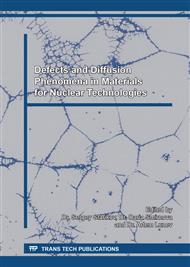[1]
C. Sari, U. Benedict, H. Blank, A study of the ternary system UO2-PuO2-Pu2O3, J. Nucl. Mater. 35 (1970) 276-277.
Google Scholar
[2]
T. L. Markin, R. S. Street, The uranium-plutonium-oxygen ternary phase diagram, J. Inorg. Nucl. Chem. 29 (1967) 2265-2280.
DOI: 10.1016/0022-1902(67)80281-1
Google Scholar
[3]
M. Kato, K. Konashi, Lattice parameter of (U, Pu, Am, Np)O2-x, J. Nucl. Mater. 385 (2009) 117-121.
DOI: 10.1016/j.jnucmat.2008.09.037
Google Scholar
[4]
K. Morimoto, M. Kato, M. Ogasawara, M. Kashimura, Thermal conductivities of hypostoichiometric (U, Pu, Am)O2-x, J. Nucl. Mater. 374 (2008) 378-385.
DOI: 10.1016/j.jnucmat.2007.09.003
Google Scholar
[5]
M. Kato, K. Takeuchi, T. Uchida, T. Sunaoshi, K. Konashi, Oxygen potential of (U0. 88Pu0. 12)O2±x and (U0. 7Pu0. 3)O2±x at high temperatures of 1673-1873 K, J. Nucl. Mater. 414 (2011) 120-125.
DOI: 10.1016/j.jnucmat.2011.01.042
Google Scholar
[6]
A. S. Bayoğlu, R. Lorenzelli, Oxygen diffusion in fcc fluorite type nonstoichiometric nuclear oxides MO2±x, Solid State Ionics 12 (1984) 53-66.
DOI: 10.1016/0167-2738(84)90130-9
Google Scholar
[7]
C. Sari, Oxygen chemical diffusion coefficient of uranium-plutonium oxides, J. Nucl. Mater. 78 (1978) 425-426.
DOI: 10.1016/0022-3115(78)90465-8
Google Scholar
[8]
M. Kato, K. Morimoto, T. Tamura, T. Sunaoshi, K. Konashi, S. Aono, M. Kashimura, Oxygen chemical diffusion in hypo-stoichiometric MOX, J. Nucl. Mater. 389 (2009) 416-419.
DOI: 10.1016/j.jnucmat.2009.02.018
Google Scholar
[9]
K. Asakura Y. Kato H. Furuya, Characteristics and sinterability of MOX powder prepared by the microwave heating denitration method, Nucl. Technol. 162 (2008) 265-275.
DOI: 10.13182/nt08-a3955
Google Scholar
[10]
J. Crank, The Mathematics of Diffusion, Second Ed., Oxford University Press, (1975).
Google Scholar
[11]
M. Kato, K. Konashi, N. Nakae, Analysis of oxygen potential of (U0. 7Pu0. 3)O2±x and (U0. 8Pu0. 2)O2±x based on point defect chemistry, J. Nucl. Mater. 389 (2009) 164-169.
DOI: 10.1016/j.jnucmat.2009.01.023
Google Scholar
[12]
H. Matzke, Atomic transport properties in UO2 and mixed oxides (U, Pu)O2, J. Chem. Soc., Faraday Trans. 83 (1987) 1121-1142.
DOI: 10.1039/f29878301121
Google Scholar
[13]
M. Kato, Oxygen Potentials and Defect Chemistry in Nonstoichiometric (U, Pu)O2, In: Stoichiometry and Materials Science - When Numbers Matter, A. Innocenti and N. Kamarulzaman, Eds., InTech, Chapter 8 (2012).
DOI: 10.5772/33672
Google Scholar
[14]
M. Kato, T. Uchida, T. Sunaoshi, Measurement of oxygen chemical diffusion in PuO2 and analysis oxygen diffusion in PuO2 and (Pu, U)O2-x, Phys. Status Solidi C 10 (2013) 189-192.
DOI: 10.1002/pssc.201200454
Google Scholar
[15]
M. Stan, P. Cristea, Defects and oxygen diffusion in PuO2-x, J. Nucl. Mater. 344 (2005) 213-218.
DOI: 10.1016/j.jnucmat.2005.04.044
Google Scholar
[16]
M. Katsuki, S. Wang, K. Yasumoto, M. Dokiya, The oxygen transport in Gd-doped ceria, Solid State Ionics 154-155 (2002) 589-595.
DOI: 10.1016/s0167-2738(02)00500-3
Google Scholar


